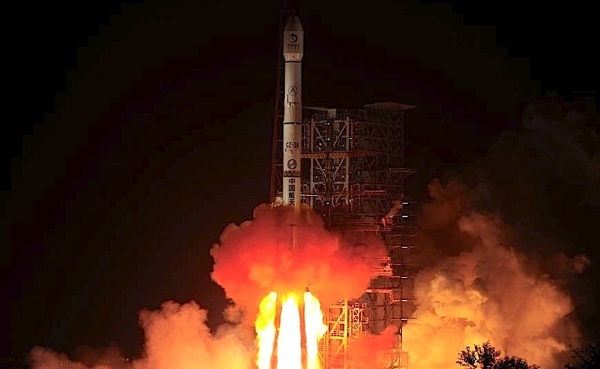China to search for rare earths in the Moon

China’s first lunar rover mission launches from a site in Xichang carrying a robotic rover called Jade Rabbit. (Screengrab from AlJazeera TV)
China has launched its first lunar rover to explore the surface of the moon, hoping —among other objectives— to discover significant deposits of rare earth minerals said to lay under the celestial body’s crust.
With the “Jade Rabbit” take-off, the Asian country could become the third nation to achieve a soft landing on the moon, after the United States and Russia. The last soft landing on the moon was the unmanned Soviet Luna 24 rover, which collected soil samples in 1976.
“We will strive for our space dream as part of the Chinese dream of national rejuvenation,” said Zhang Zhenshong, director of the Xichang Satellite Launch Center, according to the Xinhua state news agency.
The rover’s name – chosen in an online poll of 3.4 million voters – comes from an ancient Chinese myth about a rabbit living on the moon as the pet of the lunar goddess Chang’e.
Interviewed by BBC News Professor Ouyang, from the Chinese Academy of Sciences, said China is after the potential environment and natural resources the Moon holds, as the spacecraft is equipped with a round-penetrating radar to measure the lunar soil and crust.
“The Moon is full of resources – mainly rare earth elements, titanium, and uranium, which the Earth is really short of, and these resources can be used without limitation,” he was quoted as saying.
If this mission is successful, China will send another mission to gather lunar samples by 2020.
Image from AlJazeera TV via You Tube
{{ commodity.name }}
{{ post.title }}
{{ post.date }}

3 Comments
LAMB
China is certainly forging ahead in space activity. The USA was errant in not establishing a Moon Base after it’s successful Moon Landings and walk by it’s Astronauts. Rather than put money into a International Space Station it should have set up it’s own Moon Station and claimed it as their Territory – too bad they didn’t.
The USA could have started exploring for minerals even while they were there back in the late 60’s & 70’s.
Louis W. Schurmann
SRE Minerals Limited announces the results of exploration and studies
in collaboration with the Korea Natural Resources Trading Corporation of Democratic People’s Republic of Korea.
Pacific Century Rare Earth Mineral Limited (the joint venture company) has the rights to explore, mine, beneficiate and market REM in the Jongju area for the next 25 years with a further renewal period of 25 years.
Australian geological consultancy, HDR Salva has been SRE’s technical representative and has reported that the Jongju REE Exploration Target has a mineralised potential of 6.0 Bt (216.2 Mt TREO) of which 2.66% could consist of HREE.
Dr Louis Schurmann said: “The Jongju Target would appear to be the World’s largest known REE occurrence.”
Further exploration will commence in March 2014 (which will include 226,000 m of core drilling). Exploration results will be generated and reported according to JORC Code (2004 / 2012) Standards.
Dr Louis W. Schurmann is a Fellow of the Australasian Institute of Mining and Metallurgy and a Professional Natural Scientist with over 15 years of experience relevant to the styles and types of rare earth mineral deposits.
her99story
Imagine the damage to the moon controlled systems on our planet if mining takes place on the moon. Has someone done research investigating the potential negative impacts on the whole planet?